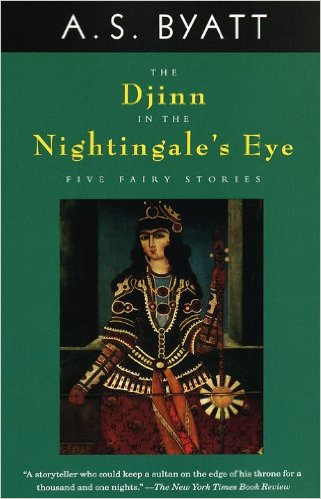The Djinn in the Nightingale’s Eye

Byatt, A.S. The Djinn in the Nightingale’s Eye: Five Fairy Stories, New York: Random House, 1997. ISBN 0-679-42008-8, $20.00.
(This review originally appeared in Mythprint 35:2 (#191) in February 1998.)
Reviewed by Ruth Berman
Byatt’s 1990 Booker Prize-winning novel Possession, although not a fantasy novel itself, was about two Victorian poets/fantasy authors (invented for the purposes of the story). She also invented some of their poems and stories. Now Byatt has published an impressive collection of fantasy stories herself. Two of the five, “The Glass Coffin” (a feminist re-working of the Grimms’ story of “The Glass Coffin”) and the ghost story of “Gode’s Story,” appeared in Possession as the work of her Victorians. The other three are more recent, the newest being the title story, which is also the longest and perhaps the most interesting (but that would be a hard call).
It reminds me of the Scheherazade section of John Barth’s threesome, Chimera, in its verve, stylistic experiments, and theme of the story-teller meditating on the nature of story-telling. In this case, it’s a present-day story-teller meditating on Scheherazade, rather than Scheherazade seen directly. (The other two stories, “The Story of the Eldest Princess” and “Dragons’ Breath,” are also meditations on the nature of story-telling.) It’s less optimistic than Barth on the possibility of any stable union possible within marriage, but Gillian the story-teller wins through to a reasonably happy-ever-after ending. She confronts the misogyny built into classics both Western (Chaucer’s “Patient Griselda”) and Eastern (Scheherazade), and when she winds up with a djinn of very own, she defeats the traditional dangerousness of wishes by a mixture of cleverness (one of her wishes is that the djinn should love her) and generosity (another is to give the djinn his own wish, which is for freedom). The balance between freedom for the djinn and his continued love for her leaves them with choices and possibilities.
One of Byatt’s attractive traits is that she keeps her characters aware of alternatives when they disagree with each other; it is rarely because one is right and the other is a fool or a villain, but rather that their choices legitimately differ. In “The Story of the Eldest Princess,” the eldest princess fails in her quest, at least in the terms set to her: the sky stays green, and she doesn’t make it blue again. But in the story as a whole, that seems to be success: “Why should things be as they always were?” asks the Old Woman. She then tells the princess brief might-have-been or might-be stories of how her middle sister achieves the quest and completes the story, but the restoration of order is not entirely to people’s liking; and of how the youngest sister follows a thread out of the completed story in search of another story of her own. And all three choices are presented as good. Byatt’s preference for the unsettled is at once unsettling and consoling.
